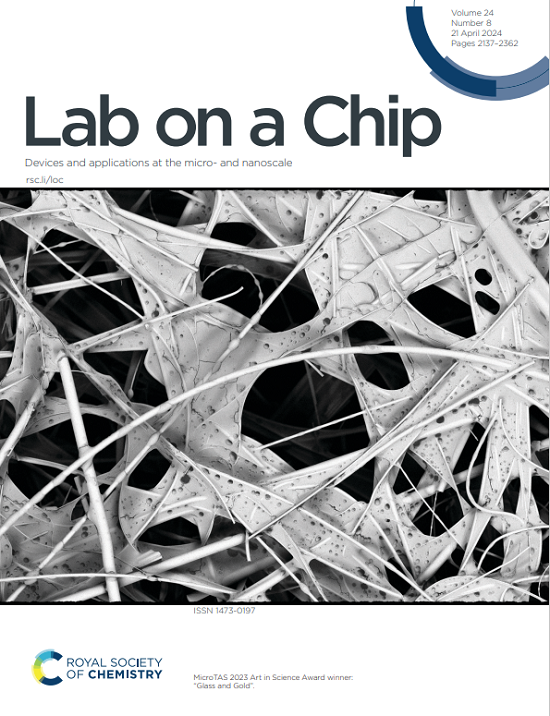Integrated microfluidic platform for on-site qPCR analysis: food allergen detection from sample to result
IF 6.1
2区 工程技术
Q1 BIOCHEMICAL RESEARCH METHODS
引用次数: 0
Abstract
Improving food safety is crucial in the contexte of “One Health” approach. To guarantee product quality and safety, food industry, having a very high turnover rate, needs short time-to-result analyses. Therefore, user-friendly systems at the point-of-need are necessary, presenting relevant analytical performances and fullfiling the current regulations. To answer these challenges, a microfluidic platform integrating sample preparation and subsequent multiplex qPCR detection has been developed for on-site testing. The system consists of a fully automated instrument driving a microfluidic cartridge dedicated to the detection of multiple allergens in complex food matrices. The first part of the microfluidic cartridge contains pumps, reservoirs, valves and a filter to achieve DNA extraction, concentration and purification. Multiplex qPCR detection is carried out in the second part of the cartridge including a negative control chamber and five chambers for target analyte detection. The in-house developed instrument contains all functions to autonomously drive the microfluidic cartridge: pneumatic control for fluid actuation, thermal control for qPCR amplification and an optical sytem using three fluorescent wavelengths for multiplex detection of the target analytes and controls. We demonstrate the simultaneous detection of four different allergens – gluten, sesame, soy and hazelnut – from various complex food matrices. The turn-around-time from sample to result is close to two hours and controls in place validate the obtained results. For gluten, a direct comparison with ELISA shows that the regulatory threshold of 20 ppm is comfortably fulfilled. Moreover, all results are in agreement with external laboratory analyses performed in parallel on the same samples. Our findings confirm that the system can be used safely on-site without risk for cross contamination between various samples to be analysed. In conclusion, our microfluidic platform offers a robust method for on-site allergen management.用于现场 qPCR 分析的集成微流控平台:从样品到结果的食物过敏原检测
在 "一个健康 "方针的背景下,提高食品安全至关重要。为了保证产品质量和安全,周转率极高的食品行业需要在短时间内获得分析结果。因此,有必要在需求点建立用户友好型系统,提供相关的分析性能并满足现行法规的要求。为了应对这些挑战,我们开发了一种微流控平台,将样品制备和随后的多重 qPCR 检测集成在一起,用于现场检测。该系统由一台驱动微流控芯片的全自动仪器组成,专用于检测复杂食品基质中的多种过敏原。微流控芯片的第一部分包含泵、储液器、阀门和过滤器,用于实现 DNA 的提取、浓缩和纯化。多重 qPCR 检测在微流控芯片的第二部分进行,包括一个阴性对照室和五个目标分析物检测室。内部开发的仪器包含自主驱动微流控芯片的所有功能:用于液体驱动的气动控制、用于 qPCR 扩增的热控制以及用于目标分析物和对照组多重检测的使用三种荧光波长的光学系统。我们演示了从各种复杂的食品基质中同时检测四种不同的过敏原--麸质、芝麻、大豆和榛子。从样品到检测结果的转化时间接近两小时,而且现有的对照组也验证了所获得的结果。就麸质而言,与酶联免疫吸附法的直接比较显示,该方法完全符合 20 ppm 的监管阈值。此外,所有结果都与外部实验室对相同样品同时进行的分析结果一致。我们的研究结果证实,该系统可以在现场安全使用,不会出现各种待分析样品之间交叉污染的风险。总之,我们的微流控平台为现场过敏原管理提供了一种可靠的方法。
本文章由计算机程序翻译,如有差异,请以英文原文为准。
求助全文
约1分钟内获得全文
求助全文
来源期刊

Lab on a Chip
工程技术-化学综合
CiteScore
11.10
自引率
8.20%
发文量
434
审稿时长
2.6 months
期刊介绍:
Lab on a Chip is the premiere journal that publishes cutting-edge research in the field of miniaturization. By their very nature, microfluidic/nanofluidic/miniaturized systems are at the intersection of disciplines, spanning fundamental research to high-end application, which is reflected by the broad readership of the journal. Lab on a Chip publishes two types of papers on original research: full-length research papers and communications. Papers should demonstrate innovations, which can come from technical advancements or applications addressing pressing needs in globally important areas. The journal also publishes Comments, Reviews, and Perspectives.
 求助内容:
求助内容: 应助结果提醒方式:
应助结果提醒方式:


